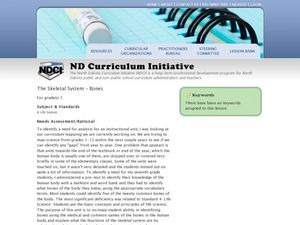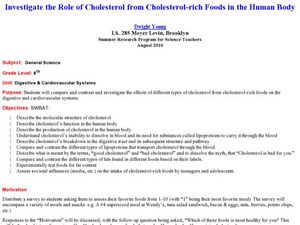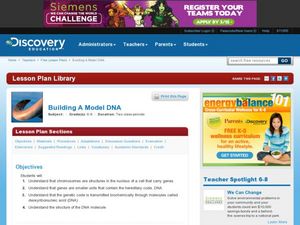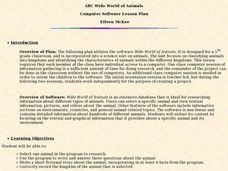Curated OER
Commercial Surrogacy: Questions & Considerations of Parties with Vested Interests
Teenagers explore the topic of surrogate motherhood. They examine the technology involved, types of surrogacy, interested groups, and current laws. Each collaborative group is assigned an interest group. They work together to develop...
Curated OER
Mitosis & Cell Processes
Students research the process of mitosis and how it progresses to the finished result of cell division. They reflect upon how this causes organisms to grow larger and helps tissues to be renewed.
Curated OER
Animals and Engineering
Students study animal classification and their interactions. In this animals and engineering instructional activity students study animal communities and how engineers use this knowledge to create new technologies.
Curated OER
Genetically Modified Foods in Perspective
Students research the concept of genetically modified foods. The purpose of the research is to increase science content knowledge and comprehension of the controversy surrounding the subject.
Curated OER
Periodical Cicada Survival
Young scholars explore defense mechanisms involved in predatory/prey relationships.They engage in a discussion about predatory/prey interactions. They reflect on the life cycle and behavior of the cicada.
Channel Islands Film
Island Rotation: Lesson Plan 3
How far have California's Channel islands moved? What was the rate of this movement? Class members first examine data that shows the age of the Hawaiian island chain and the average speed of the Pacific Plate. They then watch West of the...
Curated OER
Mechanisms to Fight Disease
Students explain how our body fight diseases. In this biology lesson plan, students identify the role of bacteria and viruses in human illness. They create a PowerPoint presentation and essay at the of the unit.
Curated OER
The Skeletal System - Bones
Seventh graders identify the common bones in the human body. In this biology instructional activity, 7th graders research two bones assigned to them. They explain why bones are important to us.
Curated OER
Fun with Phylogenetic Trees
Tenth graders differentiate angiosperms and gymnosperms. In this biology lesson, 10th graders construct a musical phylogenetic tree from information they gathered on resource websites. They present their project in class.
Curated OER
The Use of Biocards for Topical Review
Pupils create biocards to represent vocabulary from their biology course. They review and reinforce their basic knowledge of terminology, structures, or concepts. They create the cards to test themselves or classmates.
Curated OER
Seeing Cells
Sixth graders study living cells and their functioning units. In this cell lesson students color cell diagrams, answer questions and discuss the differences between plant and animal cells.
Curated OER
Poriferans and Cnidarians
Students study the major phyla of the animal kingdom. In this biology instructional activity unit, students identify their general characteristics. They define taxonomy terminologies.
Curated OER
What Happens When A Cell Divides?
Students investigate the cycle of mitosis. For this biology lesson, students discuss the different stages of mitosis through cell reproduction. They further their investigation through laboratory analysis.
Curated OER
How Cells Reproduce
Students construct a mitosis flip book. In this biology lesson, students describe the different stages of mitosis. They discuss the importance of cell reproduction.
Curated OER
Alcohol, Nicotine or Caffeine Rap
Young scholars create a rap/skit showing the effect of alcohol, nicotine or caffeine. In this biology lesson, students identify the important points of their chosen drug. They present their rap/skit in class.
Curated OER
Cell Reproduction and Inheritance
Students determine their inherited characteristics from their parents. In this biology lesson plan, students study the life of Mendel using an interactive website. They differentiate dominant and recessive characteristics.
Curated OER
Human Population Growth Simulation
Students simulate the growth of human population. In this biology lesson, students explore different perspectives on this issue. They write a reflection at the end of the activity.
Curated OER
Mountain Pine Beetle
Students identify the different parts of a tree. In this biology lesson, students investigate how mountain pine beetles kill trees. They examine the beetles' anatomy using a microscope.
Curated OER
Investigate the Role of Cholesterol from Cholesterol-rich Foods in the Human Body
Eighth graders assess fat content of different food samples. In this biology lesson, 8th graders create a flowchart showing the transport of cholesterol in the bloodstream. They perform tests for the presence of lipids on food samples.
Curated OER
Tread Lightly: Low Carbon Lunch
High schoolers create a flowchart of the carbon footprint of food from production to disposal. For this biology lesson, students brainstorm ways to reduce greenhouse gases by smart food choices. They create a blog promoting ways to eat...
Curated OER
Inside Story: Your Body, Your Health
Learners research about different genetic disorders. In this biology lesson, students create a poster highlighting facts about the disorder. They present their findings in class.
Curated OER
Introduction to Simulation Project
Students create a simulated self-sustaining ecosystem. In this biology lesson, students examine the different food chain and ecosystems in their model. They recommend some improvements and changes to an existing ecosystem.
Curated OER
Building a Model DNA
Students explain the function of DNA in the body. In this biology lesson, students build a DNA model using simple materials. They demonstrate how bases pair up in the helix.
Curated OER
ABC Wide World of Animals
Fifth graders use the software Wide World of Animals. This lesson is incorporated into a science unit on animals. The unit focuses on classifying animals into kingdoms and identifying the characteristics of animals within the different...

























